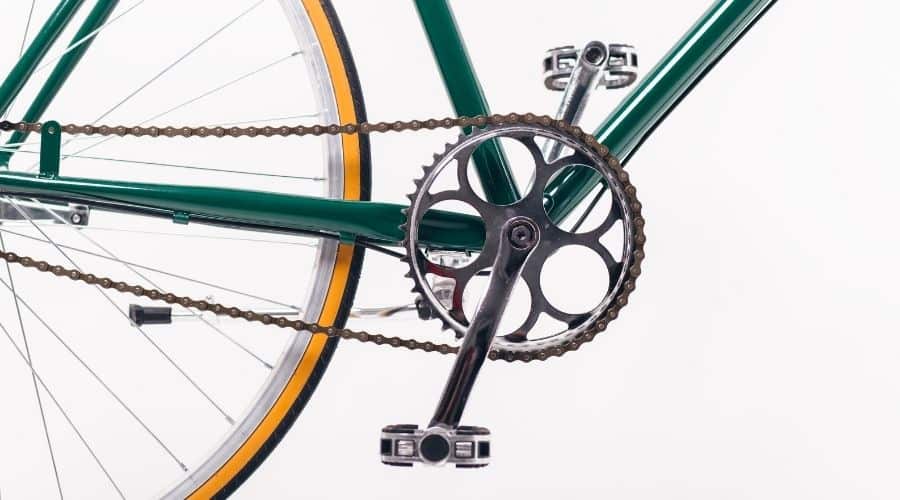The phrase ‘righty tighty, leftie loosie’ is meant to remind you which way to turn a screw, bolt, or another threaded metal piece, but it’s not always correct. The threading, a spiral cut into the metal to help it anchor in place, can go in two directions.
Most metal is threaded, so you turn it right to tighten, but reverse threading is sometimes necessary. Are bicycle pedals reverse threaded?
For bicycle pedals to spin and not unscrew themselves, the right pedal is regular threaded while the left pedal is reverse threaded. This causes the pedals to self-tighten with every rotation. To remove the pedals, turn the left pedal clockwise and the right pedal counterclockwise when facing the crank arm.
Recommended Gear
To see all of my up-to-date recommendations for bikes and cycling gear, check out this resource that I made for you!
Table of Contents
Bicycle Pedal Threads
The threads on a bike pedal are on the nub that sticks out and screws into the crank arm. That crank is what moves the chain and drive train for your bike, causing the wheels to spin.
There are holes in both sides of the crank arm that are also threaded so you can easily screw in your bike pedals.
When the pedal and crank threads meet, they should match and allow you to screw both pedals in place effortlessly.
If the pedal won’t go in the hole, it’s either on the wrong side or the wrong size pedal for your bicycle.
Are Pedals Reverse Threaded
Only the left side pedal on a bicycle is reverse threaded. This is because of the physics of how your crankshaft moves either with or opposing the pedal threads.
If you’re looking for more information on thread direction, I recommend checking out this great video from Bike Teacher.
They show you visually how to identify the threads, and they share some great information about pedal tools as well.
Learning to change your own pedals and do essential bike maintenance can save you a lot of time, money, and trouble in the future.
Why Are Bike Pedals Reverse Threaded
The left pedal on your bike is reverse threaded, so it will stay in place as you move.
Fortunately, most pedal sets are clearly marked with an embossed or painted “L” on one side and an “R” on the other, so you don’t confuse the two.
Trying to force the wrong pedal into the other side’s crank shaft will cause stripping and make the crank or pedal useless.
When adequately lubricated, a bike pedal should go into its place smoothly, whether it’s reverse threaded or not.
Why Is Left Pedal Reverse Threaded
By threading the left pedal ‘backward’ or reverse, it counters the precession from simply pedaling your bike.
The short version of the explanation is that it causes the pedal to self-tighten with every rotation.
If the left pedal had a typical thread pattern, it would unscrew simply by moving the pedals around, making it useless and prone to failure.
The simple solution was to counter the recession by swapping the direction of the threads.
As a contributor to Wikipedia so aptly explains, “Precession is the process of a round part in a round hole rotating with respect to that hole because of clearance between them and a radial force on the part that changes direction. The direction of rotation of the inner part is opposite to the direction of rotation of the radial force.”
Without this simple change, bike riding would be a lot more complicated. You would need a different way to hold the left pedal in place, or you might try using an adhesive like glue.
However, glue or a permanent fix would make changing a worn or damaged pedal nearly impossible.
Alternately, leaving it to unscrew would mean losing a part every few hundred yards, which could cause more accidents and would certainly slow you down as you stopped to replace the pedal.
Are Bike Pedals Righty Tighty
The pedal on the right-hand side of your bike is ‘standard’ or righty tighty. This is necessary to prevent the motion of the crank going around from unscrewing the pedal.
Because of the way bike pedals sit on opposite sides, pedaling forward causes the two sides to rotate opposite one another in more than one way, hence the different threading.
How To Remove Bike Pedals Step By Step
You will need a high-quality lubricant to put new pedals on and a wrench to remove the old parts.
This means a hex or Allen wrench for most bikes, but some may need a specific pedal wrench. Getting the pedals off is a surprisingly easy process.
The hardest part of changing or removing bike pedals is the ‘elbow grease’ or strength it takes to use the wrench.
I’ve detailed the process below. If this is your first time, it may take a little longer, but you can generally get the pedals off a bike in less than 10 minutes.
- Set your bike on a stand. If you don’t have a bike stand, turn it upside down and use the seat and handlebars to rest your bike.
- Check for a pedal clip. Not all bikes have them, but you must remove them first if your model does.
- Loosen the pedal spindle flat or insert a hex wrench or Allen wrench into the crank arm’s inside the port, depending on the style of pedals.
- Keep rotating until the pedal comes off the crank arm.
- That’s it. You now have a pedal off your bike. Use lubricant before placing a new pedal to help protect the threads and prevent accidental stripping.
Helpful Tips To Know If Bicycle Pedals Are Reverse Threaded
Threading on metal parts allows them to join smoothly and firmly so they hold better than they would if both pieces were smooth.
Most of the time, the standard clockwise tightening threads are ideal for every job, but it can be a problem when the parts are made to spin.
Here are more helpful tips to know if bicycle pedals are reverse threaded.
- If you reverse threaded the right-hand pedal, it will fall off just as a standard threaded left pedal would because of the motion of the cranks.
- Remember, the sides will be reversed if you have to flip the bike upside down to change the pedals.
- Not all bike pedals are interchangeable. It’s vital to know what size pedals your bike uses or new parts may not fit.
Final Thoughts
The threading on bicycle pedals can seem confusing at first. Especially if you are new to changing bicycle parts, it doesn’t make sense that the right pedal comes off properly, but the left seems to refuse to budge.
Once you understand precession and look at how the pedals spin, it’s easy to see why the left pedal must be reverse threaded for safety.
After all, cycling wouldn’t be much fun if you had to stop every couple of minutes to fix a pedal, and bikes would cost a lot more if you had to damage the cranks every time you needed a new pedal.

